

(NOTE: these photographs were taken in 1983; excavations and new discoveries have continued since then.)The ownership of this large (460' x 330') country estate in central Sicily has been debated. Once thought to be a retirement home of the Emperor Maximian, it is now suggested that the owner had connections with Africa. A mosaic depicting a personification of Africa and the long hallway mosaic depicting the capture and transport of exotic animals give credence to this speculation. It is also thought that the mosaic artisans were from North Africa. This unwalled estate has a complicated asymmetrical plan with rooms in a variety of shapes and with various changes of axis.The side with the baths in the background and the heating system for the baths' waterThe original entrance was to the right--today with free-standing columns and without a roof. Plexiglass roofs and internal catwalks protect the remains of most of the structure and floor mosaics. | ||
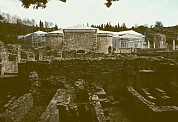 |
 |
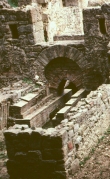 |
The frigidarium with mosaics depicting Cupids as fishermen | ||
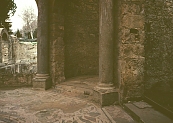 |
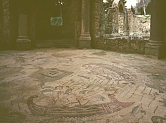 |
 |
The peristyle and one of the small rooms | ||
 |
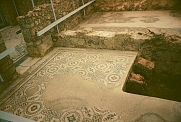 |
The glory of this large villa is the mosaic decoration. Over forty rooms are covered by about 4200 square yards of mosaics, some purely decorative, others with narrative subject matter. |
Another room with fishing Cupids | ||
| In addition to mythological and decorative motifs, the themes of the mosaics include fishing cupids, the hunt of local animals (as one of the pastimes of noble Roman landowners), the capture of wild animals, and chariot racing. |  |
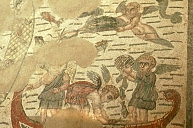 |
 Click here to see page 2--hunt mosaics.
Click here to see page 2--hunt mosaics.
 Click here to return to index of art historical sites.
Click here to return to index of art historical sites.
 Click here to return to index of artists and architects.
Click here to return to index of artists and architects.
 Click here to return to chronological index.
Click here to return to chronological index.
